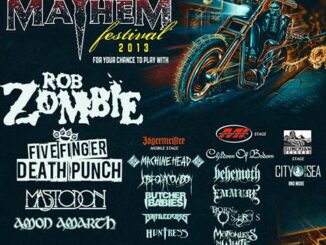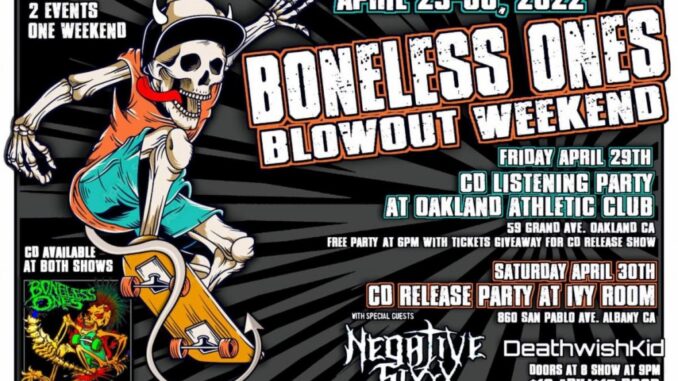
THE BONELESS ONES
Featuring Max Fox, Troy Takaki, Craig Locicero, and Chris KontosÂ
It Doesn’t Get More Bay Area Crossover Than This
Back To The Grind dropping Friday, May 13th
Bay Area skate punk/thrash/crossover band BONELESS ONES is back.  After a 35 year hiatus the guys said,â Hey-what the fuck!!!â â¦Thatâs three-plus decades of sonic dominance and counter-culture benefaction. Now, The Boneless Ones find their contumacious voice again on Back to the Grind via their own label, Thunder & Lightning Records.
After laying the foundation for West Coast Punk rockers a mere 36 years ago venerated skate punk/cross-over legends The Boneless Ones celebrate their much-anticipated return with new album, Back to the Grind. Featuring founding members Max Fox (vocals) and Troy Takaki (bass) with erstwhile drummer Chris Kontos (ex-Attitude Adjustment, ex-Machine Head) and new guitarist Craig Locicero (Dress the Dead, ex-Forbidden), the Bay Area quartet breathe present-day life into the sounds/customs that crucially bridged punk, hardcore, metal, and skateboarding. In fact, it was appearances on pivotal compilations Them Boners Be Poppinâ (Boner) and Skate Rock Volume 3 – Wild Riders of Boards (Thrasher) that set up debut album Skate for the Devil for near-continuous reverence from the day of its release in 1986 to its most recent re-issue via Beer City Records in 2020.
âWe knew what we were doing with Back to the Grind would be well received,â says vocalist Max Fox. âIt was from the soul. We started with skateboard music, and there was no concept style-wise of what that was back then, so it was all so fresh. When Beer City Records started talking to us about re-issuing Skate for the Devil, we also started to think about writing a new album. Obviously, the original idea was for The Boneless Ones put out another record after Skate for the Devil back in the day. That didnât happen. Itâs been over 30 years, but weâre finally back!â
âOut of the blue, I got a call from Chris and Max,â Troy Takaki says. âThey said, âHey, do you wanna play the Haight [Ashbury] Street Fair?â The fair had organized reunion shows with all these â80s bands. After I left The Boneless Ones in â87, I didnât really touch my bass again. So, I went to my garage, took out my bass, and practiced for the first time in decades. We eventually agreed to play the Haight [Ashbury] Street Fair show, after which we said to ourselves, âShould we keep playing?â So, we played [skate legend] Randy Katenâs birthday party with Fang in Sacramento in 2019. That was hugeâsold out! Then, we played the Exodus benefit show for Tom Hunting. Thatâs when things started to evolve into what The Boneless Ones are today.â
âAbout a year and a half ago, Troy and I started putting some ideas together for new music,â says Fox. âThe writing was cathartic, joyfulâall those things. When Chris returned from doing the anniversary shows with Machine Head, it all started to really gel. We knew we had to continue the tradition of having a great guitar player, so Chris had the idea to ask Craig to join. We got Craig, thankfully, and he really took to it. We set up a songwriting room at Chris‘s house. We had four songs from our ’87 demo, which we reworked together. Then, we wrote nine more kick-ass songs. Writing with Troy, Chris, and Craig was an incredible experience.“
âI was standing there at their last show at UC Berkeley in â86,â guitarist Craig Locicero adds. “I thought, ‘Man, that guitar player [Skeels] is way too good for a punk band.’ That’s what was going through my head. Then, they broke up. When Chris approached me, and after meeting with the rest of the guys, I was stoked. I immediately knew how and where to swing for the fences. Musically, we picked up right where they had left off in â86. My background is not just technical thrash metal. I have a lot of flavors that I can add to the music. Hardcore punk is one of them.â
About :The Boneless Ones
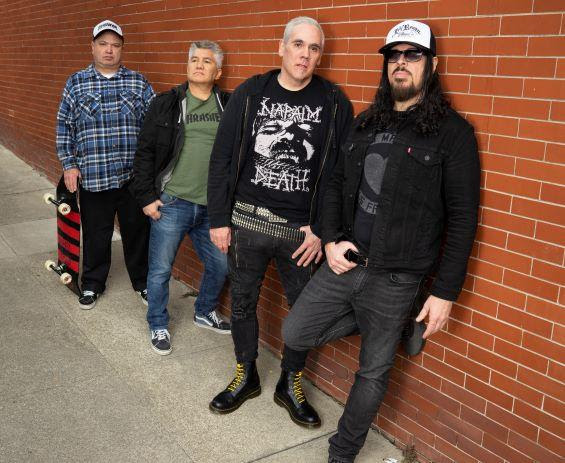
photo by Timi Devlin
The Boneless Ones formed in Berkeley, California, in 1984. Initially, they werenât even a musical groupâmore a cadre of Pro-Am aspiring punks aligned to a single skate-or-die goal. The genesis of the moniker goes back to Fox and cohort Takaki pilfering boneless stickers from grocery store meat departments. They plastered the âbonelessâ red decals everywhere. Then, still, without a band, they designed a logo. When a skate photo of Fox, Takaki, and ripper Joel Chavez appeared in East Bay fanzine Cometbus, they were mistaken for a real-life band. Naturally, Chavezâs trickâcalled a âbonelessââcombined with youthful guerilla marketing tactics had paid off. The Boneless Ones were officially born. Obligatory lineup changes eventually coalesced into Fox and Takaki bringing in Joe Satriani-educated guitarist Luke Skeels and Fang drummer Tim Stilletto. Not long after, the quartet wrote and recorded Skate for the Devil with Kevin Army. The rest, the adage goes, is history.
Skate for the Devil was constructed with spontaneous spirit, fresh-faced grit, and a middle-finger attitude. Whatever was to come after classics like âKeg Kept a Flowinâ,â âLove to Hate,â âMiss Fresno,â and âSkate for the Devilâ had to have the same impetus, a similar tongue-in-cheek constitution, and above all, continued adoration for all things skateboarding. Not for nothing but Thrasher Magazine called âSkate for the Devilâ one of the greatest skate rock songs of all time. So, high bars had been set. With heavy hearts from the passing of Skeels (R.I.P. October 26, 2020) and good friend Eddie Jennings and palpable nostalgia in their minds, The Boneless Ones reconvened not as a reunion band but as an entity driven to create anew. Indeed, Kontos (originally in the band’s â86 and â87 configurations) and Locicero provided indispensable firepower and aptitude to the overall songwriting sessions. The Boneless Ones pulled four unreleased tracks (âTied to a Stake,â âChurch of Violence,â âIn the Cold,â and âFaces of Deathâ) from a long-lost â87 demo while the band minted up-to-date songs in âBack to the Grind,â âWe Ride the Night,â âBlood on the Streets,â and âI Wish You Were a Beer,â the follow-up to âMiss Fresno.â Back to the Grind is real, and it surpasses all expectations.
Back to the Grindis an album steeped in Bay Area rootsâthe vibrant Berkeley scene, Ruthieâs Inn, et al.âbut itâs not a retread musically. Yes, old songs have been retooled. Yet, itâs the new songs whereThe Boneless Onesoverwhelmingly shine rebellious, wax dynamic (fast and slow), and hit harder than metal to concrete. The guitar hero antics ofSkeelare still imbued inLociceroâs contributions, and the tongue-in-cheek humor of the groupâs formative years remains intact. Thereâs no confusion in direction, however. This is skate rock/cross-over music, as poignant today as it was in the mid-â80s. Thatâs evident from the old-school gallop ofâChurch of Violenceâand the shout-out grind ofâCrossing Overâto the launch-ramp pulse ofâGood Friendsâand theVanishing Point-informedâBlood on the Streets.âFor a bunch of guys with miles on their backs and stories to tell,Back to the Grindillustrates that itâs never too late to resurrect and persist once more that which matters most.
“We wrote the whole record in the spare bedroom at my house,” says drummerChris Kontos. “I was on electric drums. I kept it caveman. I didn’t want a Machine Head or Gojira-level drumming style on this record. The record needed to be played on a steering wheelâlike air drums.Craigwas really hitting on some Rikk Agnew [Christian Death, Adolescents] moments on this record. He also understood the skate theme that we were going for. The modern [recording] tech going straight into my computer really helped our playbacks. We finally had a quality pre-production from that. We all had our parts down by the time we were ready to go in and record.”
The Boneless Ones are, if anything, chroniclers. Musically, thatâs tangible throughout Back to the Grind. Lyrically, Fox has lived a life, and all that comes with it. Themes of brotherhood, lost love, reflection, and skateboardingâa scene in which the vocalist remains very activeâare woven throughout the lyrical outlay. Indeed, âBack to the Grindâ hits on never letting go, while âBones of Rockâ pays homage to rock ânâ roll; heartbreak is tackled on âIn the Cold,” and âGood Friendsâ honors the unfortunate passing of a friend; âCrossing Overâ takes on the tenets of Bay Area cross-over music, and the bands that inspired it. Back to the Grind is a testament to the last 35 years of Foxâs life.
âThereâs two different styles I write in,â Fox says. âThereâs storytelling songs and songs that tell a story. I wrote a lot of the new songs from the heartâthings that have happened in my life. Theyâre âlife songs.â Iâve lived my life, and I have stories to tell. Iâm conscious that not every song needs to be a long and drawn-out novella. Some of the songs are playful, fun, and joyful. But thereâs a very serious side to us, too. Both sides are important to us, and I think they define what The Boneless Ones were and are now.â
Kevin Army and his trusty 8-track recorder did the job on Skate for the Devil in â86. The Boneless Ones (and technology) have moved on, however. The group enlisted producer Zack âThe Wizardâ Ohren (Machine Head, Fallujah) and Oakland-based Sharkbite Studios to properly capture Back to the Grind. The sessions were rigorous yet productive. On the first day, Kontos got through 10 of the 13 songs, while Fox nailed the vocals in two days. The Boneless Ones then brought on Grammy Award-winning mixing engineer Matt Winegar (Fantastic Negrito, Primus) and mastering guru Ed Littman for Ed Littman Mastering to ensure Back to the Grind would boom and grind from loudspeakers at skateparks to streaming playback.
âZack was good,â says Takaki. âHe was there with us from the get-go. You always know where you stand with Zackâhe speaks his thoughts. So, he helped us clean up our act. Chris was incredible. His playing is so physical. After the drums, we did bass and rhythm guitar. Now, we record everything individually. I work in movies, so I understand the theory, but this is the first time I recorded the bass by myself. The recording was so much different from the first album. We definitely pulled favors to get the music recorded 1,000 times better than it shouldâve been.â
Where The Boneless Ones go from here is determined by fun and feels. That’s how they started, and that’s how they’ll continue on. Certainly, the years of covert marketing via Hollywood movies (Diary of a Wimpy Kid [as Löded Diper], The Bounty Hunter), skate videos (Monster Energy Drink and Thrasher Magazine âMagic Maka Busâ with pro Grant Taylor), and appearances in other mediums have helped The Boneless Ones stay front and center. The tradition carries on with music spots in downhill skater documentary Nick Broms: Whatâs the Rush? and HBO Max series Dead Boy Detectives. Renowned artist Mark DeVito (Metallica, Motörhead) completes the Bay Area circle with a raging cover piece and a cool new slime-green logo design. The kegs keep flowinâ, the partyâs never dull, and most importantly, the grinds are always gnarly with The Boneless Onesâs Back to the Grind.
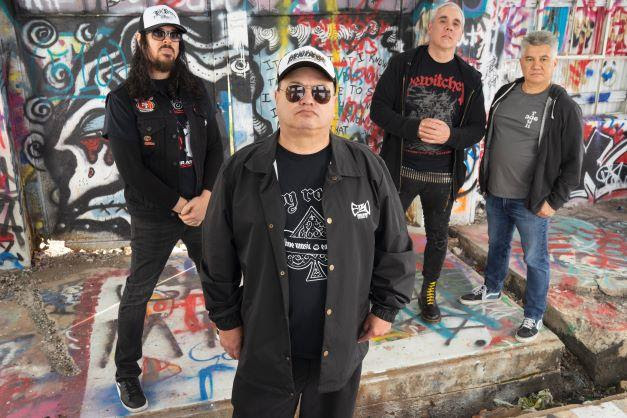
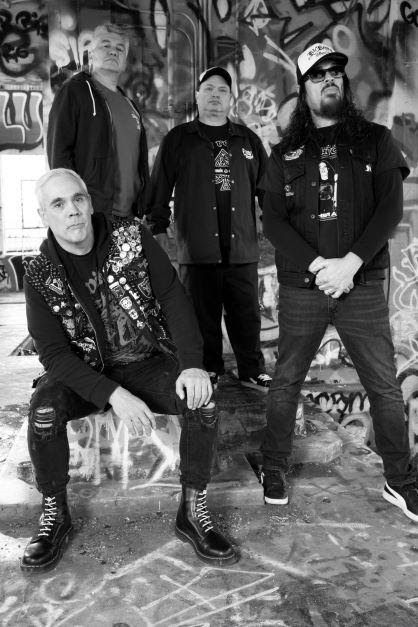
photo by Timi Devlin



